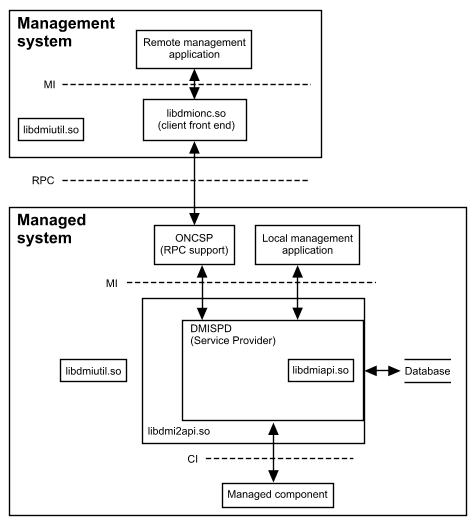Implementation architecture
The overall structure of this DMI implementation is shown in
the following diagram.
``DMI 2.0 system elements''
illustrates the components that make up the DMI system. An
explanation of the elements follows the figure.

DMI 2.0 system elements
The elements listed in the diagram are:
Remote management application-
A management application communicating with the SP via RPC.
This is usually on a remote machine but can be on the local machine.
In the latter case, the RPC transactions simply ``bounce'' back
from network loopback and are handled as if from a remote machine.
Client front end-
This provides the DMI 2.0 MI interface on the
management station.
libdmionc.so-
Library implementing the client front end.
ONCSP (RPC support)-
A daemon which makes the Service Provider's MI
interface available over RPC. From the Service Provider's
perspective, this looks like a normal local management application.
Local management app-
A management application running on the local machine and making calls
directly to libdmi2api.so. When a component wishes to
install its MIF, it usually uses this interface to temporarily pose
as a management application.
DMISPD (Service Provider)-
This implements core DMI 2.0 functionality. Its CI
and MI interfaces are made available through libdmi2api.so
libdmiutil.so-
Miscellaneous support functions used by many of the other
components. There is a copy of this library on both systems.
lib2dmiapi.so-
Service provider's DMI 2.0 interface for local components and
local management applications.
libdmiapi.so-
A legacy DMI 1.0 interface.
It is retained for SP internal use only.
Managed component-
One of a number of DMI components being managed.
The libraries are discussed in more detail in
``DMI package procedure libraries''.
Next topic:
Operations
Previous topic:
Implementation specific details
© 2004 The SCO Group, Inc. All rights reserved.
UnixWare 7 Release 7.1.4 - 27 April 2004

